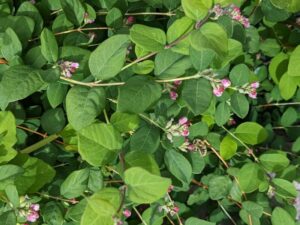Friends of Trees, Friends of Bees
How we can plant to promote native pollinators
Next time you see a bee buzzing around your garden, take a closer look. It’s cute, right? And on top of that, it’s performing a very important ecological process—pollination!
Last month we hosted two pollinator workshops in Washington county during National Pollinator Week, thanks to funding from the Tualatin Soil and Water Conservation District. Folks gathered at the PCC Rock Creek Learning Garden and at Tualatin River National Wildlife Refuge to take a tour of pollinator-friendly plants, learn what makes for good pollinator habitat, and to spot some native bees along the way. Friends of Trees staff shared their knowledge on the topic and led activities to guide people in designing their own pollinator gardens.
What is a pollinator? Pollinators are animals (mostly insects) that move pollen from a flower’s male part to its female part in their search for sustenance, making that plant’s reproduction possible. This process makes pollinators a really key part of both agricultural and ecological systems. 35% of our food sources and 75% of flowering plants depend on pollinators.
“Unfortunately, we’re seeing a massive, unprecedented decline in native bees and other pollinators,” says Thomas, a Neighborhood Trees Specialist at Friend of Trees who studied pollinator ecology and conservation in graduate school. In some countries, studies have shown more than 75% decline in insect biomass in 30 years. Because pollinators are relatively understudied, the impacts and ramifications of this decline are not fully understood.
“There are a lot of contributing factors, including pesticide and herbicide use, grazing practices, agricultural monocultures, habitat loss and climate change,” Thomas says. “It’s scary, but there are still things we can do.”

IN OUR OWN BACKYARDS
We can create habitat in our own backyards and parks. Luckily, we don’t need entire wilderness areas for pollinators to live in. You can help by planting a variety of flowering plants to provide food for pollinators from spring all the way into fall.
“Trees are particularly helpful here because they flower earlier in the year than most smaller flowering plants, providing food for early-season pollinators like bumble bees” Thomas says. “Trees like California buckeye, cascara, hawthornes, willows, and fruit trees are all great options for native pollinators.”
It’s also best to cultivate a diversity of flower shapes, colors, and types to attract a diverse array of pollinators. Bees, butterflies, and flies are all pollinating insects looking for different types of food.

NATIVE PLANTS FOR NATIVE POLLINATORS
It makes sense that native pollinators are attracted to native plants. Our Green Space program enhances natural areas by planting many thousands of native shrubs and plants each planting season, improving air and water quality and creating habitat for wildlife, including pollinators.
“A lot of our Green Space plantings are designed to improve water quality in particular,” says Kaitie, a Green Space specialist. “But these plants are great for pollinators, which is more than just an added bonus.”
Plants like red-flowering currant and Oregon grape are common at our Green Space plantings and favorites for pollinators. Our Green Space plantings also leave open ground where bees can nest.
Many people express concern for honeybees, not realizing that honeybees come from Europe and can potentially outcompete native bee species. There are over 4,000 native bee species in the United States and over 650 in Oregon.
“There’s a lot of growing interest in pollinators,” Thomas says. “It was exciting to see that at our pollinator workshops with great turnout, in-depth conversations, and the chance to send folks home with pollinator plants.”
The best things we can do to protect and promote native pollinators are to avoid using pesticides and herbicides on our properties, plant flowers and native plants, and leave things a little messy so that pollinators can make themselves at home in our gardens.

